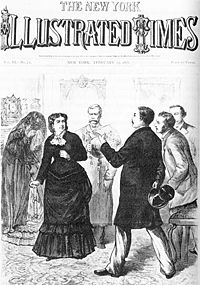Quick Facts
Biography
Ann Trow (May 6, 1812 – April 1, 1878), better known as Madame Restell, was an early-19th-century abortionist who practiced in New York City.
Biography
Restell was born in Painswick, Gloucestershire, England. Her father was a labourer. At the age of fifteen she started work as a maid in a butcher's family, and at sixteen she married a Wiltshire man called Henry Summer. After three years living in England, they emigrated to New York in 1831 where Summer died of yellow fever. Restell was forced to make a poor living as a seamstress.
Restell remarried in 1836, to a German–Russian immigrant, Charles Lohman, who worked in the printing trade. Lohman was a radical and freethinker, a friend and colleague of George Matsell, the publisher of the radical journal the Free Inquirer. With Matsell, Lohman was involved in the publication of Robert Dale Owen's book Moral Physiology; or, a Brief and Plain Treatise on the Population Question (1831) and Charles Knowlton's Fruits of Philosophy; or, The Private Companion of Young Married People (1831).
Restell's brother, Joseph Trow, had also emigrated to New York, and was working as a sales assistant in a pharmacy. Restell began to develop an interest in women's health, selling patent medicine, and (probably in partnership with her husband and brother) creating birth control products such as "preventative powders" and "Female Monthly Pills", advertised under the name "Madame Restell". She sold these products through the post and performed house visits. The term "Restellism" became a euphemism for abortion.

Her business was one of a number at the time, and like them was under constant attack by the respectable and the penny press. Newspaper editor Horace Greeley criticized other newspapers for accepting advertisements by Restell, and George Washington Dixon of the Polyanthos as well as the National Police Gazette also refused her advertisements.
In 1840, a patient named Maria Purdy accused Restell of causing her tuberculosis through the abortion procedure. The press erupted with slander against Restell, calling her "the monster in human shape" and charging her with acts against God. Restell promised monetary compensation for anyone who could prove her methods were dangerous, and while she was initially found guilty, her appeal overturned said verdict. Her uneasy relationship with public opinion continued.
In 1841, Mary Rogers was found dead in the Hudson River. Newspapers suggested that she had died during an abortion carried out by Restell. Abortion was soon outlawed in 1845. Soon it became legally defined as an obscene subject and was no longer covered in the papers.
Charges were again brought against Restell in 1847 for performing an abortion. Contradictory testimony led to Restell's conviction on a less serious charge, and she spent a year in prison. Upon release, she resumed her practice in a new location.
Evidence given in a breach-of-promise case in 1854 suggests Restell and her husband were charging between $50 and $100 per abortion at this time and had a regular clientele. The complainant in the case claimed to have had five abortions over a period of seven years, of which three were performed by Restell. At this time abortion in New York was a felony punishable by not less than one and not more than three years in prison. In a further court case Restell conceded she had arranged the adoption of an unwanted child. Politician Anthony Comstock, posed as a customer looking for birth control pills and brought the police round the next day to have her arrested. Following Restell's arrest in early 1878, a maid discovered Restell in the bathtub at her Fifth Avenue home; she had slit her own throat on the morning of April 1, 1878. Upon her death, she was found to be worth between $500,000-$600,000 ($12.4 million-$14.9 million in present-day terms).
Literature
Ann Trow Lohman is acknowledged as the inspiration for Kate Manning's heroine Annie "Axie" Muldoon in her historical novel My Notorious Life, published on June 6, 2013 (UK) by Bloomsbury Publishing.
Madame Restell is also a prominent character in Marge Piercy's historical novel, "Sex Wars", which depicts the social and political climate surrounding women's sexual, physical, and reproductive activities during the Gilded Age.
Restell features as a minor character in Gore Vidal's novel 1876.
